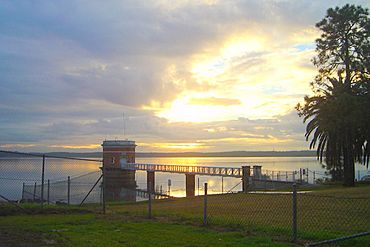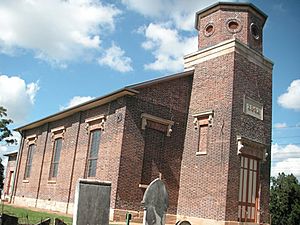Prospect, New South Wales facts for kids
Quick facts for kids ProspectSydney, New South Wales |
|||||||||||||||
|---|---|---|---|---|---|---|---|---|---|---|---|---|---|---|---|

The Prospect Reservoir at sunset
|
|||||||||||||||
| Population | 5,187 (2021 census) | ||||||||||||||
| Established | 1791 | ||||||||||||||
| Postcode(s) | 2148 | ||||||||||||||
| Elevation | 78 m (256 ft) | ||||||||||||||
| Location | 32 km (20 mi) west of Sydney CBD | ||||||||||||||
| LGA(s) | City of Blacktown Cumberland City Council | ||||||||||||||
| State electorate(s) | Prospect | ||||||||||||||
| Federal Division(s) | |||||||||||||||
|
|||||||||||||||
|
|||||||||||||||
Prospect is a suburb in Sydney, New South Wales, Australia. It is about 32 kilometres west of the Sydney central business district. Prospect is part of the City of Blacktown and a small part of Cumberland City Council. It is also part of the Greater Western Sydney area.
Prospect is one of Sydney's oldest suburbs. It gets its name from Prospect Hill. From the top of this hill, people could see a great distance across the countryside.
Long ago, Prospect was a place for former convicts to settle. Later, it grew into a small village. Over time, settlers cleared land for livestock, churches, inns, schools, and shops. A large reservoir was also built here. Famous naturalist Charles Darwin even visited Prospect in January 1836 to study its geology.
Contents
History of Prospect
Early Aboriginal Life and European Arrival
Before 1788, the Darug people, including the Warmuli group, lived in Prospect. They followed a traditional lifestyle connected to the land. As European settlers arrived, their way of life became very difficult.
Prospect Hill became a key area where Aboriginal people strongly resisted the new settlements. Lieutenant Watkin Tench likely named Prospect Hill in April 1790. In July 1791, land grants were given to former convicts in Prospect. By January 1794, farmers at Prospect Hill were very successful.
Conflict and Resistance
Prospect became a border between the colonists and Aboriginal people. Tensions grew, leading to a type of guerrilla warfare by 1797. This conflict, part of the Hawkesbury and Nepean Wars, involved Aboriginal people and settlers in Prospect and Parramatta.
The Aboriginal resistance was led by Pemulwuy, a leader from the Bidjigal tribe. Pemulwuy led many raids against the colony in the 1790s. In 1797, his group began regular raids on settlements around Parramatta and Prospect Hill. British military efforts failed to capture him.
Early European Settlements and Homes
Around 1808, William Lawson was given about 500 acres (2 square kilometres) of land at Prospect. He built a large house called Veteran Hall. Most of this property was later covered by the Prospect Reservoir. The house itself was demolished in 1926.
Nelson Lawson, William Lawson's son, built "Greystanes House" before 1837. It was a grand family home with beautiful gardens. The house was known for its fancy parties. Greystanes House was demolished in the 1940s.
Building the Prospect Reservoir
From 1806 to 1888, the land was used for farming. In 1867, a plan was made to improve Sydney's water supply. The Upper Nepean Scheme was designed to bring water from the Nepean River to a reservoir at Prospect.
The Prospect Reservoir was built between 1880 and 1888. It became Sydney's fourth water supply system. Edward Orpen Moriarty was a key engineer behind this important project.
Changes to the Landscape
By the 1870s, farming of grains in the area had declined. The Prospect Hill area was mostly used for raising livestock. Many of the earliest settler homes had disappeared by this time.
On January 30, 2004, the eastern part of Prospect became a new suburb called Pemulwuy. This new suburb includes the quarry area and parts of Prospect Hill. So, most of Prospect Hill is no longer within the suburb of Prospect.
Quarrying companies mined dolerite rock from Prospect Hill for roads. This quarrying removed much of the hill. The Prospect quarry is now part of Pemulwuy. Quarrying stopped in 2007. In the early 2010s, the quarry area was turned into a light industry zone. The Prospect Highway now runs through this area.
Important Places in Prospect
Prospect has several places that are listed for their historical importance:
- Upper Canal System
- Great Western Highway: Veteran Hall Remains
- Ponds Road: St Bartholomew's Anglican Church and Cemetery
- Reservoir Road: Former Great Western Road Alignment, Prospect
- Reservoir Road: Prospect Reservoir
- East of Reservoir: Prospect Reservoir Valve House
- 385 Reservoir Road: Royal Cricketers Arms Inn
- 23 Tarlington Place: Prospect Post Office
- Clunies Ross Street: Prospect Hill
- Reservoir Road: Prospect Hill Reservoir
Geography and Environment
Landscape and Nature
Early descriptions of Prospect mention it as a "very pleasant tract of country." It had widely spaced trees, gentle hills, and grassy slopes, looking like a huge park. The soil was a mix of loam and clay. The main trees were eucalypts like grey box and forest red gum. Spotted gum also grew in the area.
Climate in Prospect
Prospect has a humid subtropical climate. Summers are warm to hot, and can be humid or dry. Like much of western Sydney, most rain falls in late summer and early autumn. Drier conditions happen between late winter and early spring, but rainfall can be unpredictable.
Prospect usually has 104 clear days each year. August has the most sunny days (13.2), and February has the fewest (5.0 days). Prospect is often a few degrees warmer than the Sydney CBD in spring and summer. This is especially true when hot winds from the Australian desert push temperatures above 40°C. However, Prospect is usually cooler at night because it is further from the coast.
The highest temperature recorded in Prospect was 45.1°C on January 7, 2018. The lowest was -0.8°C on June 30, 2010. On average, temperatures drop below 2°C about 3.2 days a year.
| Climate data for Prospect Reservoir 1991–2020 averages, 1887–present extremes | |||||||||||||
|---|---|---|---|---|---|---|---|---|---|---|---|---|---|
| Month | Jan | Feb | Mar | Apr | May | Jun | Jul | Aug | Sep | Oct | Nov | Dec | Year |
| Record high °C (°F) | 47.0 (116.6) |
46.4 (115.5) |
39.5 (103.1) |
37.1 (98.8) |
29.4 (84.9) |
25.6 (78.1) |
26.5 (79.7) |
29.4 (84.9) |
35.0 (95.0) |
39.0 (102.2) |
42.0 (107.6) |
44.4 (111.9) |
47.0 (116.6) |
| Mean daily maximum °C (°F) | 29.3 (84.7) |
28.6 (83.5) |
26.8 (80.2) |
24.1 (75.4) |
20.7 (69.3) |
17.7 (63.9) |
17.2 (63.0) |
19.3 (66.7) |
22.4 (72.3) |
24.8 (76.6) |
26.1 (79.0) |
28.0 (82.4) |
23.8 (74.8) |
| Mean daily minimum °C (°F) | 18.0 (64.4) |
18.0 (64.4) |
16.2 (61.2) |
12.9 (55.2) |
9.7 (49.5) |
6.1 (43.0) |
6.6 (43.9) |
6.6 (43.9) |
9.5 (49.1) |
12.1 (53.8) |
14.5 (58.1) |
16.4 (61.5) |
12.3 (54.1) |
| Record low °C (°F) | 10.0 (50.0) |
10.8 (51.4) |
7.9 (46.2) |
3.6 (38.5) |
1.2 (34.2) |
−0.8 (30.6) |
−0.6 (30.9) |
−0.5 (31.1) |
1.7 (35.1) |
4.5 (40.1) |
6.8 (44.2) |
7.8 (46.0) |
−0.8 (30.6) |
| Average precipitation mm (inches) | 96.4 (3.80) |
126.9 (5.00) |
97.4 (3.83) |
67.4 (2.65) |
49.5 (1.95) |
76.1 (3.00) |
40.7 (1.60) |
39.7 (1.56) |
42.2 (1.66) |
55.3 (2.18) |
77.1 (3.04) |
75.5 (2.97) |
845.0 (33.27) |
| Average precipitation days (≥ 1mm) | 8.3 | 8.7 | 9.2 | 6.5 | 5.3 | 7.0 | 5.6 | 4.2 | 5.1 | 6.6 | 8.2 | 8.2 | 82.9 |
| Average afternoon relative humidity (%) | 52 | 54 | 55 | 50 | 57 | 54 | 52 | 43 | 45 | 44 | 51 | 51 | 51 |
| Source 1: Prospect Reservoir (1991–2020 averages) | |||||||||||||
| Source 2: Prospect Reservoir (1965–2018 extremes) Horsley Park (1997–present extremes) | |||||||||||||
Landmarks to Explore
- Prospect Hill, located in Pemulwuy, is a famous landmark. It is important in the early history of New South Wales. The suburb of Prospect is named after this hill. The hill was also a source of dolerite rock, which was quarried for roads.
- Prospect Reservoir is in Prospect Nature Reserve, part of the Western Sydney Parklands. It is a large water storage area. Around the reservoir, you can find picnic spots, playgrounds, and public parking.
- St Bartholomew's Church of England is an old brick church with a cemetery. It holds the tomb of Lieutenant William Lawson and graves of early pioneering families. It is a protected heritage site.
- Raging Waters Sydney is a big water park in Prospect. It opened on December 12, 2013.
- Hylands Inn was an old inn and a stop for Cobb & Co coaches in the 1880s. Horses would rest in the paddocks. Today, it is used as a youth centre. It was one of five hotels operating when the Reservoir was being built.
- Royal Cricketers Arms is a hotel built in 1877. It is one of the few old roadside inns left from the Great Western Highway. It is also one of the last remaining buildings from the old Prospect Village. The building has a mix of Victorian and Georgian styles.
Getting Around Prospect
Prospect is close to the Great Western Highway and the M4 Motorway. These roads connect Prospect to western Sydney and to the Sydney CBD.
The Prospect Highway connects Prospect to central Blacktown.
You can reach Blacktown railway station for Sydney Trains and NSW TrainLink services. Several bus companies offer services between Prospect and Blacktown.
People of Prospect
Who Lives Here: Ancestry and Birthplace
According to the 2021 census:
- The most common ancestries in Prospect are Australian (19.6%), English (16.4%), Indian (10.3%), Chinese (5.7%), and Maltese (5.7%).
- 53.7% of people were born in Australia.
- Other common birthplaces include India (7.4%), Philippines (3.3%), Fiji (2.9%), Sri Lanka (2.3%), and New Zealand (1.9%).
- 23.9% of people had both parents born in Australia, while 62.2% had both parents born overseas.
Languages Spoken at Home
- 50.9% of people speak only English at home.
- Other languages spoken include Arabic (5.7%), Hindi (3.5%), Tamil (3.2%), Gujarati (2.7%), and Punjabi (2.6%).
Religious Beliefs
The most common religions in Prospect are:
Famous People from Prospect
- Pemulwuy was a leader of the Bidjigal tribe. He led Aboriginal resistance against the colony in the 1790s, including raids in the Parramatta and Prospect Hill areas.
- William Lawson was an explorer who, with Gregory Blaxland and William Charles Wentworth, found a route across the Blue Mountains in 1813. He owned land in Prospect and built Veteran Hall there.
- Natasha Crofts received the Australian Mother of the Year Award in 2007.


